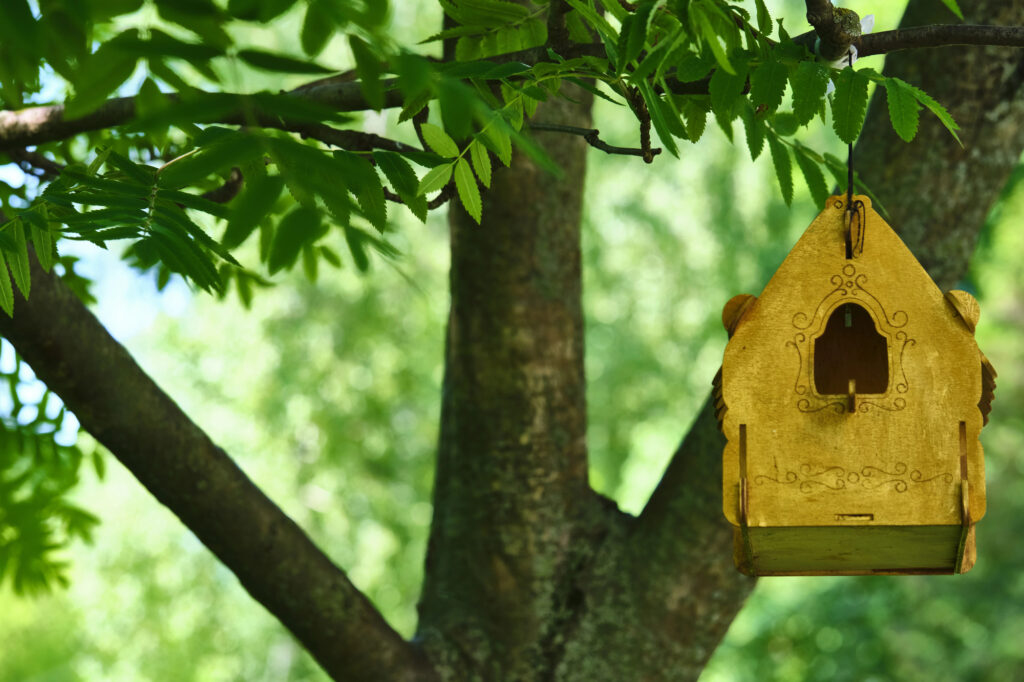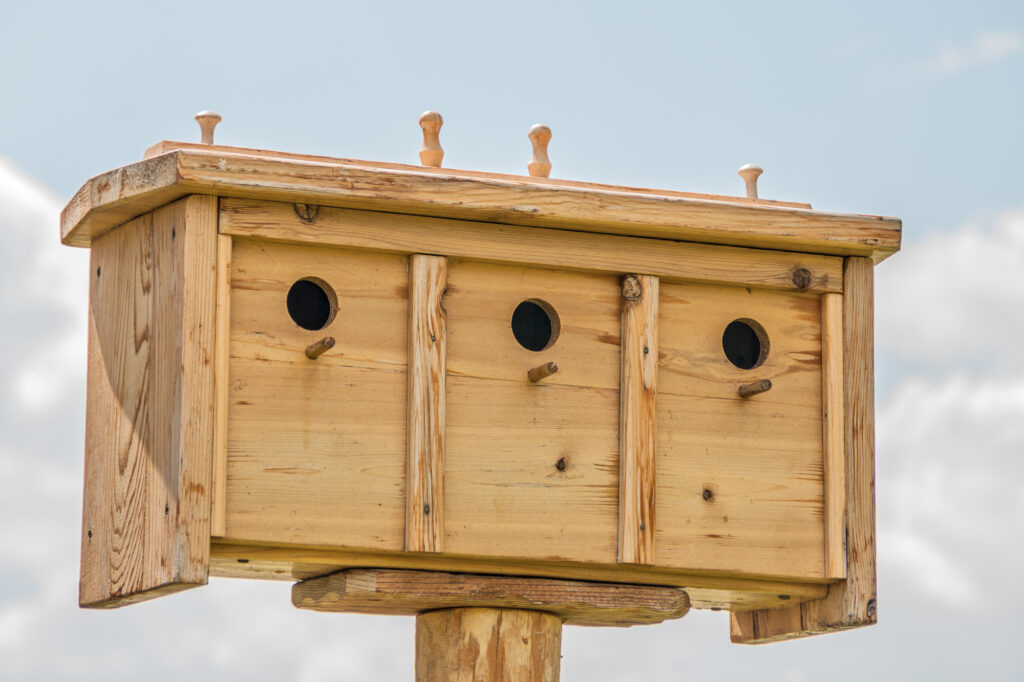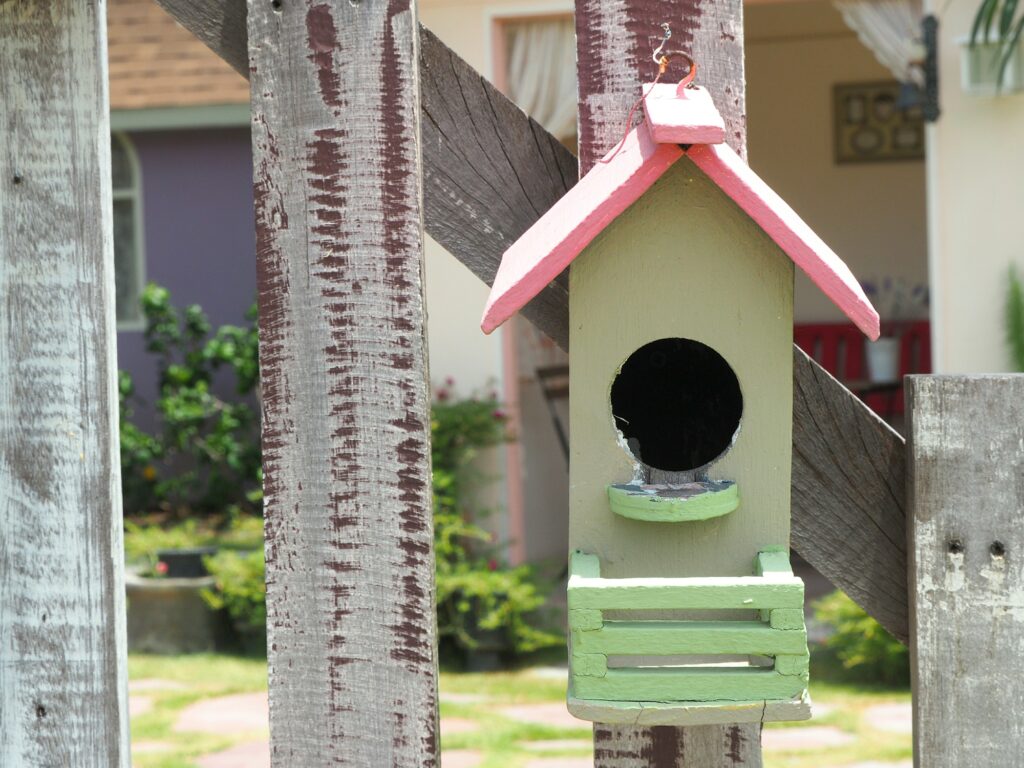Spring is just around the corner, which can only mean one thing – it’s time to start putting up birdhouses! But choosing the right place to install your nest box is a fine art indeed.
While many people can be a little slap-dash about putting up a bird box, inappropriate placement all too often leads to the boxes never being used, or worse still, falling victim to predators or foul weather.
Here we’ll take a look at some of the most common errors people make when installing birdhouses and how to avoid them to encourage happy families of birds to return year after year.
Placing Your Birdhouse at the Wrong Height

Many people wonder how high to site their nest boxes, but the answer depends on which birds you’re trying to attract!
North American bird nesting authority nestwatch.org suggests that for most small birds, 5-12ft is a good range, but there are nuances. Carolina wrens and bluebirds, for example, prefer their nest boxes only 4-6ft high, whereas purple martins and violet-green swallows prefer nesting at 10-15 ft from the ground.
Large birds like raptors, and ducks like nesting even higher up. American kestrels and screech owls need nest boxes placed 10-30 ft from the ground, whereas ducks like mergansers and goldeneyes prefer boxes placed 6-25ft high.
If you are interested in siting a nest box for ducks, just remember that their young will leap from the nest box well before they’re able to fly. Make sure there’s nothing hard or sharp in the vicinity to ensure a safe landing!
Nest Boxes Too Close Together

While some birds nest communally, it’s more common for pairs to become territorial at nesting time and often won’t tolerate other birds of the same species breeding in their vicinity at all.
Once again, the proximity with which birds nest alongside each other depends on the species. Whereas Carolina chickadees and violet-green swallows will tolerate their own species nesting just 30 feet away, black-capped chickadees and tufted titmice prefer to maintain at least 600 feet from their neighbors.
Unsurprisingly, birds of prey need to give each other an even wider berth! Screech owls need at least 1000 ft between each other’s nest sites, and kestrels prefer a minimum of half a mile!
But while birds of the same species will often fight fiercely for a nest site, pairs of different species are often quite happy to live alongside each other in peace. In such cases, it can often pay to site nest boxes right next to each other, in pairs.
Nest Boxes Too Far Apart
Following on from our last point, certain species of bird are happy to share their nesting area with neighbors of another species – some species will even accept nestboxes facing back-to-back with their neighbors on the same pole!
A good example of this is tree swallows and bluebirds that will both chase away other members of their own kind but are quite content nesting alongside each other. In this case, nest boxes can either be placed 15-25 ft away from each other or on the same pole, 5-6 ft off the ground.
Pairing boxes like this is a good way to host multiple bird species in a small space. It also makes birdwatching more fun, as sitting beside a pair of nest boxes in the breeding season, you’ll be able to compare how the parents of different species build their nests and feed their young.
Facing Wrong Direction
Although some types of birds seem indifferent as to which direction their birdhouse is facing, others are more picky.
According to nestwatch.org, all types of bluebirds have an order of preference for which direction their nest site faces. Facing east is their favorite, followed by north, and south. Since the west is their least favorite direction, avoid this orientation if you want to attract them!
The same authority also states that tree swallows prefer east-facing sites, kestrels and Northern flickers prefer their nest boxes facing south or east, and wood ducks prefer south or west.
Also, consider that nest boxes facing prevailing winds are more likely to get buffeted by rain. Chickadees, titmice, and nuthatches, in particular, all prefer to have their nest boxes facing away from prevailing winds.
Too Close to Bird Feeders and Bird Baths
People sometimes imagine that birds would enjoy having their nest box right beside their feeder or bird bath. That way they’d have less distance to fly to drink and feed their young, right?
Well, not quite! The busy comings and goings of multiple bird species at feeders and bird baths are actually off-putting for nesting birds, and bird houses placed too close to feeders and baths may not get used at all.
To build their nests and raise their young in peace, birds prefer a quiet space where they won’t be intruded upon. To be on the safe side, place your nest box at least 15 feet away from your bird feeders and bird baths.
Nest Boxes Without Protection
You’ll probably know that nesting can be a dangerous time for birds. Squirrels, raccoons, cats, mice, and snakes are all known for raiding nest sites in search of eggs or nestlings as an easy meal.
It’s for this reason that poles are often recommended over siting nest boxes on trees. PVC or metal poles are harder for predators to climb, and adding a baffle or predator guard to them helps to deter potential thieves even further. But what if you’ve got your heart set on placing your nest box in a tree?
A 2021 scientific study from Spain tested a new type of guard for protecting nest boxes from snakes. By wrapping a 3-foot-high sheet of acetate around the tree below the nest box, researchers found that only 2% of boxes were predated, compared with 20% of nests with no protection.
In conclusion, poles with baffles are the easiest way to protect nests from predators, but trees can also be guarded if you’re prepared to go the extra mile!
Close Proximity to Agro-Chemicals
It’s a sad fact, but chemical farming and gardening are extremely detrimental to birds – especially at nesting time.
Because pesticides are directly harmful to bird health and also wipe out their food source of insects and other invertebrates, anywhere near sites that use such chemicals are best avoided.
Golf courses, arable fields, and gardens that use insecticides and herbicides are not good sites for nest boxes, as doing so could encourage birds to nest in a potentially dangerous place.
For the best chances of your birds raising a healthy brood of offspring, we highly recommend adopting organic gardening methods and leaving some overgrown areas of your yard for birds to forage among native wildflowers, rock piles, and brush.
Out of Sight
This particular mistake will not affect your birds adversely, but it could reduce your viewing pleasure of birds building their nests and raising their young, not to mention the joy of watching the chicks fledge!
While most birds will appreciate a relatively quiet and secluded place to build their nests, that doesn’t mean you need to place it out of sight. If you do, chances are you’ll miss most of the wonderful moments of wild bird breeding altogether.
Instead, place your birdhouse within an easy eyeshot of a kitchen or bedroom window that you frequently gaze out of so you can enjoy the miracle of nature while you’re lying in bed or washing your dishes.
Alternatively, locate it around 15-25 ft from somewhere that you love to sit outside. I prefer nothing more than sitting out with a cup of tea on a late spring evening watching my flycatchers zip back and forth to feed their offspring. The devotion with which birds raise their young can be an inspiration to us all.
Too Close to Human Activity

The converse mistake of locating your nest box out of sight is placing it too close to your daily activity. While a few bird species such as house wrens have no problem building their nests on your front porch, most birds need more distance from human activity to feel safe.
As a young boy, I remember being very disappointed after putting up a nest box just behind our garden swing chair in the hope that I could observe the birds from my cozy seat. But because there was nearly always someone swinging there, they never used it. They must have felt intimidated by our proximity.
Such mistakes are useful lessons to understand birds better. Although many backyard birds can appear to be remarkably bold at times, during nesting time, they’ll usually appreciate a little more seclusion.
Wrong Local Habitat
If you’ve got your heart set on attracting a particular type of bird to your nest box, you’ll need to place it in the appropriate habitat.
Because birds need to nest in the right habitat to feel safe and source an abundant supply of food, many species can be quite choosy. While Carolina wrens will nest anywhere from dense forests, to suburban parks, to your metal mailbox, others such as nuthatches, bluebirds, and swallows are more particular.
If you’re considering installing a specialist nest box for birds like owls and ducks, you’ll need to choose the habitat extremely carefully. Ducks, unsurprisingly need to nest near water, and barn owls like to nest in man-made structures with open, weedy fields, deserts, or marshlands nearby.
We don’t have time to describe the nesting habitat of every bird species, though. For that, please head to the excellent index at nestwatch.org to find out the very best environment for each species.

